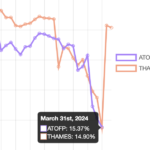There have been plenty of words written about the high-yield corporate bond market in the last week, but sometimes a chart expresses things better than words.

The Markit iBoxx $ Liquid High Yield index includes almost 1000 different junk bonds and is tracked by the biggest junk bond exchange-traded fund. When you look at the market value of these constituents grouped together by sector, an interesting picture emerges.
If junk bonds are suddenly unfashionable, no one seems to have told sectors like consumer goods or financials, where bonds trade above par. The losses that everyone talks about are concentrated in the oil, gas and mining sectors. Given the global rout in commodities seen over the past year it shouldn’t be a surprise that companies that borrowed on the basis of higher prices are now struggling to repay lenders. In fact, the only reason that more of these companies haven’t gone bust already is that they bought hedges against commodity price declines.
Knowing that the problem is sector-related, in equities the solution would be straightforward. There are a plethora of tools for expressing a sector view: buy the sectors you like, buy the index and hedge the sectors you dislike, and so on. High yield is different. Unlike equities, no sector-specific high-yield funds exist, and aside from illiquid single name credit default swaps, no targeted hedging instrument is available. If you are worried about the impact of commodities on your high-yield portfolio, the only option is to sell the entire portfolio, or hedge the index.
There are hundreds of funds and ETFs that invest in high-yield corporate bonds. When I did a search on Bloomberg just over a year ago I found 460 such funds (excluding ETFs) with assets above $250 million. Collectively, these funds owned junk bonds worth $750 billion. Now fast forward to today. The largest 30 of these funds have seen their assets under management decline by $59 billion in the past 12 months. When you factor out negative investment returns, that implies net outflows of $45 billion. To get a feel for the size of this number, it’s equivalent to the four biggest US insurance companies liquidating their entire junk bond portfolios. In other words, the contagion effect is real.
When I started looking at high yield bonds I focused on ETF flows because this is the easiest place to look. With their daily liquidity, there is an argument that ETFs are a more sensitive risk indicator than harder-to-track mutual fund flows. However, junk bond ETFs are relatively small part of the market, with total assets of around $60 billion. Moreover, the aggregate flow data points in the opposite direction to mutual funds, with $7 billion pouring into high yield bond ETFs in the last year, according to Markit, although the trend reversed itself in the last month. While ETF investors may or may not be smarter than their traditional fund brethren, the 12-month inflows are dwarfed by the outflows from mutual funds, lessening the data’s significance.
When I last wrote about high yield bonds, I was struck by the surge in new issuance that began in 2009. After peaking in 2013, this issuance has slowed with $255 billion of US high yield bonds this year, 15% below last year’s level according to industry group Sifma. High-yield leveraged loan issuance is also down, according to S&P. Is this slowdown enough to compensate for the retrenchment by mutual funds? Given the surge in issuance before 2015, that may not happen fast enough if investors go on strike.
At present, there is only one practical way of hedging against losses in high-yield corporate bonds, which is to buy protection on a basket of default swaps such as the Markit CDX.NA.HY index. The price of this protection has surged in recent weeks, trading at a higher spread than the equivalent spread for the iBoxx high yield index. Could the ballooning CDX.HY be a leading indicator of problems to come, like the ABX index was in 2007? There are two problems with this argument.
Firstly, the CDX.HY is a lousy hedge for the commodity-related troubles that our chart reveals in the iBoxx high yield index above. It’s not even a good hedge for the iBoxx as a whole: there’s no ‘big short’ here. Second, there aren’t many more CDS hedges actually being done. The Depository Trust & Clearing Corporation publishes weekly data for outstanding notional amounts in the CDS market, and for index CDS, notionals have declined from $1.2 trillion a year ago to just below $1 trillion today. Net notional trades on the CDX.HY index have crept up by $3.5 billion during this same period. Probably the best that can be said is that high-yield CDS index hedging has increased in relative, but not absolute importance.
Before the 2007-8 crisis, investment banks like Morgan Stanley regularly got caught with their pants down when the high-yield market turned sour, stuck with warehouses of bonds they couldn’t sell. Dodd-Frank and the Volcker Rule have mitigated some of that risk, and today Morgan Stanley is probably too busy cutting fixed income staff to blow up in the ways of old.
But bank lending has seen fewer regulatory changes since the crisis, and here is where some eye-opening exposures can be found. Consider Citigroup, which says it has $60 billion, or 11% of its $555 billion wholesale loan portfolio in energy-related assets, along with another 10% in power, commodity and mining-related assets. That’s a higher weighting to these sectors than the iBoxx index, with a total exposure amounting to more than two thirds of Citi’s core equity tier 1 capital.
At least Citi provides this breakdown. Other banks, such as Deutsche Bank, don’t tell you what their energy-related loan exposure is. When problems loom in a corner of the credit market, the banks are the first place you should look, so long as they let you.
Comments are closed.
 Levelling the Playing Field
Levelling the Playing Field
 Barclays and Labour's growth plan
Barclays and Labour's growth plan
 Plummeting bonds reflect souring UK mood for outsourcing and privatisation
Plummeting bonds reflect souring UK mood for outsourcing and privatisation
 Dimon rolls trading dice with excess capital
Dimon rolls trading dice with excess capital
off topic i know but this is an interesting read:
http://www.coindesk.com/bitcoin-triffin-dilemma/
Rob
Thanks….amazing how thin some of the issues are…plenty of notionals in the $500-$1500 range which wd trade as micro/small caps in equity world